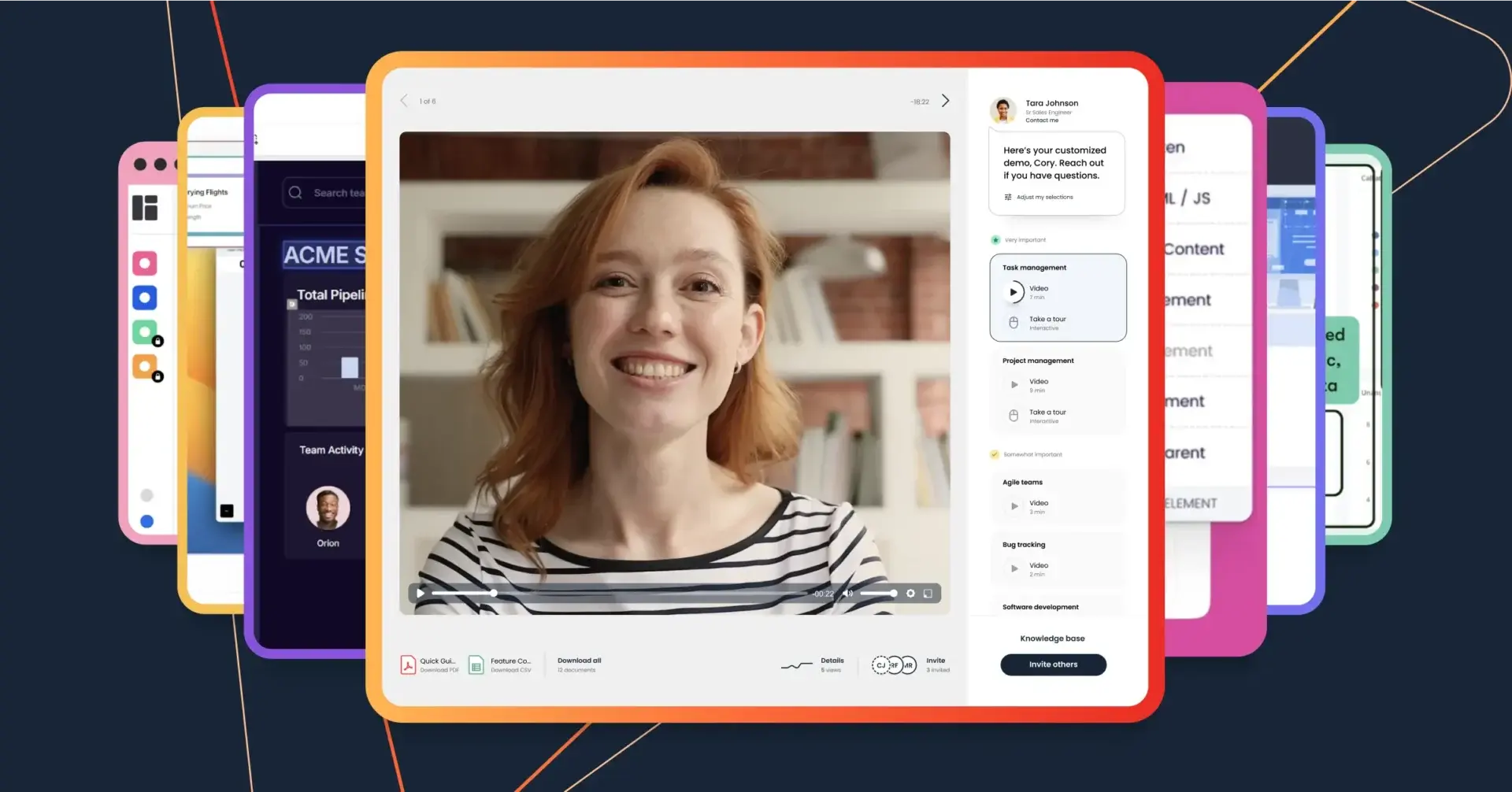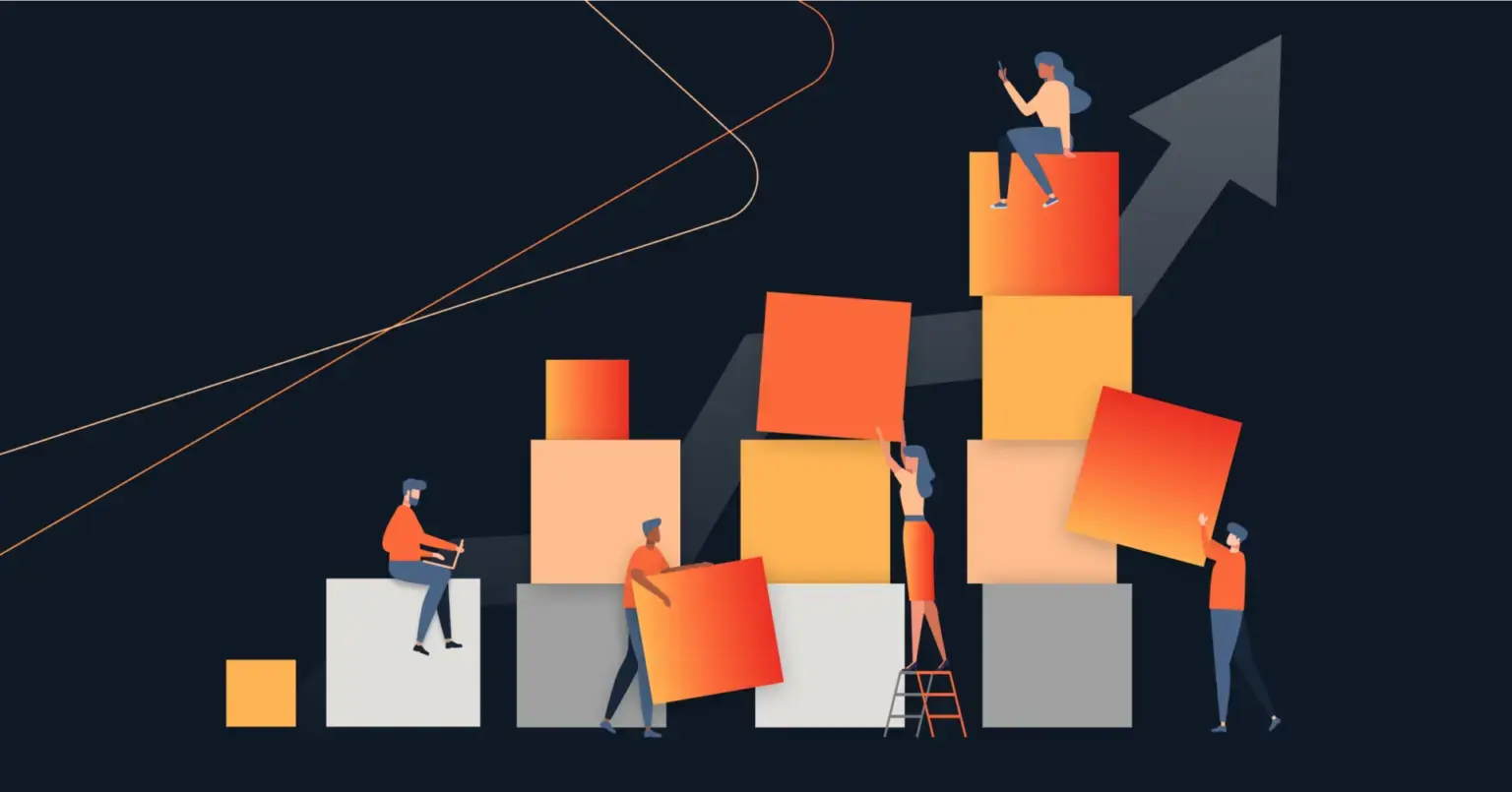
Rex Galbraith
CRO Consensus
Rex, CRO at Consensus, has selling in his blood. It only took closing his first deal for him to be ...
Close more deals with
Demo Automation.
Watch a Demo
Selling has changed. Why? Because buying has. Today’s buyers are highly informed, incredibly discerning, and under more pressure than ever to justify every purchase. They’re not looking for another pitch—they’re looking for proof. That’s why they’re diving deep into research before they ever raise a hand. In fact, more than 20% of B2B buyers now spend up to 19 hours per month researching potential solutions, while another nearly 10% are clocking in at a staggering 40 hours.
But here’s the kicker: after all that effort, most still walk away unsure of what they need. Not because the right solution doesn’t exist, but because they haven’t been shown how to connect the dots. They haven’t had anyone help them define the gap: the space between where they are right now and where they need to be to reach their goals.
The solution? Gap selling.
Gap selling reframes the sales conversation entirely. Instead of leading with features, it starts with the problem. It’s all about diagnosing the current state, uncovering the pain points, and clearly mapping a path to the desired future state. It’s consultative. It’s strategic. And most importantly—it’s buyer-first.
Outdated sales techniques that rely on generic pitches, linear scripts, or rapid-fire feature dumps just don’t cut it anymore. Because there’s never been a buyer who said, “I want to buy a product that doesn’t solve my problem.” Gap selling makes sure that doesn’t happen.
What Is Gap Selling? Understanding the “Gap” in Sales
Gap selling is a problem-centric sales methodology that focuses on identifying the measurable space between a buyer’s current state and their desired future state. That space—the “gap”—is where value lives. Sellers who can define, quantify, and connect their solution to that gap win more often and close faster.
Here’s how it works:
- The current state includes the buyer’s existing problems: inefficiencies, missed targets, manual processes, system limitations, or anything else. Understanding the current state requires more than surface-level discovery. Sellers can ask questions that uncover hard facts based on missed KPIs, manual workflows, budget overruns, or customer churn rates. They need curiosity, business acumen, and the ability to assess the full impact of the problem at all levels: financial, operational, and emotional.
- The future state is what the buyer wants to achieve: revenue growth, operational efficiency, reduced risk, strategic transformation, etc. Sellers must help buyers articulate what success looks like. That includes concrete goals, timelines, and outcomes. The more detailed the future state, the easier it becomes to create urgency around closing the gap.
- The gap is the space between those two states. The gap is the space between what is and what could be. It’s where the pain of inaction and the value of change live. The bigger and more painful the gap, the more motivated the buyer becomes to solve it. A seller’s job is to make that gap visible and measurable. That means putting real numbers to problems and outcomes. When sellers expose the true cost of staying in the current state, they position themselves as problem-solvers, not product pushers.
How Consensus Helps You Sell “Between the Gaps”
While defining the gap is essential to guiding the sale, it’s also where most sales teams lose traction. You can have the perfect discovery call, map out the buyer’s current and future state, and align on a compelling vision—but then there’s a lull. Days or even weeks pass between meetings. And during that time, buyers are still researching, inviting new stakeholders, and comparing competitors. You’re not in the room—but your competition might be.
Consensus’ Product Experience Platform closes that gap.
By delivering on-demand, personalized product experiences across the buyer’s journey, Consensus helps you sell both live and between meetings. Your demos and product tours don’t sleep—they’re always working, always available, and always aligned to your buyer’s current and future state.
Take a look at how Consensus supports each stage:
- MQL Stage: The buyer watches an on-demand video introducing a high-level value prop—sparking interest without needing to book time.
- BDR Call: They engage with a static tour that shows how to perform basic tasks—building early confidence.
Sales Appointment: Now fully engaged, the buyer experiences a dynamic product tour that illustrates your full workflow—and their team tests features through automated simulations. - Presales Appointment: A follow-up on-demand video answers lingering questions across the buying group.
- Closing Appointment: Every stakeholder is already informed, aligned, and ready to make a decision.
This continuous thread of engagement means your team is always selling, even when they’re not in the room. Consensus allows buyers to experience your product 24/7, giving them the flexibility to explore solutions on their terms—and keeping your product front and center when it matters most.
Consider how Frontline Education succeeded when it started focusing more on bridging the gap for its buyers. Using Consensus’ Product Experience Platform, Frontline Education transformed how it demonstrated its value. Their demos showcased a potential future state by showing what the buyer could accomplish with their school health management solution. Offering on-demand content lets their buyers uncover the gap between the current and future state on their own time and at their own pace.
The result? Demo views reached over 17,000 and 1,244 leads converted from those demos. Showcasing the gap is smart selling—and using demo automation tech to do it is even smarter.

Benefits of “Selling in the Gap”
Revenue teams that embrace gap selling consistently outperform those stuck in product-first approaches because they focus on what really matters: the buyer’s current state, where they want to go, and what’s holding them back. That “gap” becomes your biggest sales lever.
These benefits just scratch the surface of what’s possible with gap selling.
Improve Lead Qualification
Gap selling forces reps to dig deeper before moving any deal forward, an approach that complements comprehensive lead qualification in modern pipelines. They ask smarter questions. They uncover missed KPIs, operational bottlenecks, and strategic blockers. If there’s no problem worth solving, the deal doesn’t progress.
More than 65% of lost sales happen due to a lack of proper lead qualification. Gap selling keeps money in your pipeline by finding you the right leads. Presales teams stop wasting time on low-value opportunities. AEs focus on deals with real urgency. Your pipeline becomes more accurate, forecasting gets easier, and your team spends more time where it counts: helping buyers solve real business challenges.
This is where Consensus gives you a serious edge. Consensus streamlines early discovery with intelligent, interactive demos and engaging product tours that do the heavy lifting up front. It gives your high-intent buyers access to your product faster, so they can self-educate at their own pace.
In the meantime, your team captures behind-the-scenes insights—what roles are engaging, which pain points resonate, and how deep the need really goes. You can discover new stakeholders and engage every persona with relevant content to drive alignment and close deals—30% faster.
Need help qualifying your leads? Explore Consensus’ Product Experience Platform.
Or, get started now with this complete lead qualification checklist.
Boost Close Rates
Buyers don’t buy features—they buy solutions to painful problems. Gap selling helps your team quantify those problems and link them directly to your product’s value. Instead of pitching, your sellers lead consultative conversations that connect the dots between inefficiency and impact.
This approach earns trust fast, aligns stakeholders early, and reduces objections.
Nearly 100% of B2B purchases are driven by organizational changes, which means buyers are looking to solve long-term, internal challenges that affect multiple parts of an organization. They need to know how your solution is their solution. When buyers can clearly see how your solution moves the needle on their business, closing becomes a no-brainer.
Shorten Sales Cycles
Gap selling helps sellers prioritize the right opportunities and drop the ones going nowhere. If there’s no measurable problem like lost revenue, churn risk, or manual overhead, there’s no reason to move forward. But once the gap is clear, stakeholders align, momentum builds, and sales cycles move faster.
Automated demos and product tours allow sellers to shorten the sales cycle even when they’re not in the room (which is the case for about 90% of the sales process). In their own time and at their own pace, buyers explore solutions that directly address their pain points, helping them to identify the gap on their own.
With Consensus, revenue teams can create automated, personalized demos that can be sent in between meetings, keeping deal momentum high. By determining your buyers’ gaps early, you can provide interactive product experiences that speak directly to their pain points, demonstrate tailored value, and accelerate their journey toward a decision. And, buyers can become familiar with your winning product on their own time, without eating away at calendar hours for your sales team.
Strengthen Customer Relationships
When you lead with the buyer’s goals, you earn credibility from day one. Gap selling turns your reps into trusted advisors who focus on diagnosing problems, rather than pushing products. Buyers feel seen, understood, and heard.
That trust carries through the entire relationship. Post-sale, CS teams can use the original gap to guide onboarding, prove ROI, and drive adoption. When sales teams deliver what they promise, renewals and expansions take care of themselves.
A product experience platform strengthens this connection by aligning the product story with buyer needs from the first touchpoint. It gives prospects the freedom to explore on their own terms, making it easier for them to understand how your solution solves their specific challenges. Because these insights are captured and carried through the sales cycle, handoffs to customer success are smoother, onboarding is more relevant, and ongoing engagement is built around what matters most to each customer. The result? Stronger relationships, higher satisfaction, and more predictable growth.
Common Challenges When Selling in the Gap
Gap selling is a powerful approach, but it’s not one-size-fits-all. To do it well, sales teams need a deep understanding of the buyer’s world, the object-handling skills needed to push back on challenges, and the communication skills to become a confidante and supporter for their buyer.
But if handled poorly, the deal loses momentum fast. Here’s where sellers often stumble—and how to avoid it.
Discovery That Doesn’t Go Deep Enough
The biggest trap is rushing discovery. Too many sellers ask generic questions and skip straight to the pitch. The result is that you reveal symptoms, not root causes. And without uncovering the real business pain, there’s no defined gap, just a vague interest in features.
That’s how conversations go from high-impact to forgettable. Great discovery requires slowing down, digging deeper, and connecting pain to outcomes.
Struggling to Quantify the Pain
You might uncover a problem, but can you prove it’s costing the business? Sellers often stop short of assigning a measurable impact. Without real numbers, like dollars lost, hours wasted, and churn rates rising, buyers won’t feel urgency. The solution becomes “nice to have” instead of “need to fix now.” Quantifying impact turns a technical issue into a strategic priority.
Selling Below the Line
If you’re only talking to mid-level managers or technical contacts, you’re likely missing the full picture. The typical B2B buying group has six to 10 stakeholders, but are you reaching them? And what do they know about your product? When you sell “below the line,” you may be targeting people who aren’t in a position to be making purchasing decisions.
Strategic deals require access to decision-makers who care about business outcomes, a core principle for building better relationships with enterprise buyers.
Avoiding the Tough Conversations
Gap selling requires asking hard questions: What’s the cost of doing nothing? How much revenue did this issue cost you last quarter? Where is the breakdown in execution? Sellers who shy away from discomfort often miss the truth hiding in plain sight.
Buyers don’t need another “friendly check-in.” They need someone who recognizes they’re trying to buy change, not just software, and is prepared to help them fix what’s broken.
Sales and Presales Misalignment
Even when sales nails discovery, the deal can still derail if presales doesn’t anchor their enablement content and tools to the buyer’s pain. Presales must reinforce the gap uncovered in discovery, not just show off functionality.
When sales and presales align around the buyer’s challenges, the buyer gets a complete product experience that’s designed for them and their use case, making them more likely to see the value of your solution.
Trying to Solve Everything at Once
Gap selling is about focus. Trying to uncover every problem in one call overwhelms the buyer and dilutes urgency. Rather than trying to solve every problem, zero in on the biggest pain points with the biggest business impact. Then, build your case around that.
Clarity wins, while complexity kills deals. And with more than 75% of B2B buyers saying that their last purchase was way too complex, you stand out when you manage to keep buying simple. Gap selling works when you stay focused on the buyer’s problems, rather than just talking about your product. Stay sharp, stay curious, and always lead with value.
How to Implement Gap Selling in Your Organization
Closing deals is no longer about pitching faster. It’s about diagnosing deeper. Gap selling helps sales teams uncover what truly matters to buyers by asking purposeful, problem-centric questions and then guiding them across their gap with insight, empathy, and precision.
Gap selling requires intentional discovery, smart data collection, and a relentless focus on buyer outcomes. Here’s how to put it into motion across your organization.
1. Start with the Facts
Before diving into goals or pitching solutions, your reps need to understand the buyer’s current state. That means getting grounded in specifics: team structure, tech stack, workflows, timelines, and known pain points.
These facts build credibility and replace assumptions with proof. Encourage your team to ask quantifiable, impact-focused questions like:
- “How many hours a week does your team spend on this process?”
- “What’s the average cost of an error in your current workflow?”
- “How many people are currently involved in this workflow?”
- “How long does it typically take to complete this process from start to finish?”
- “Are there any upcoming projects or initiatives that will increase the urgency to solve this?”
The more concrete the data, the clearer the business case.
2. Uncover the Real Problem
Once the current state is mapped, it’s time to dig deeper. What’s really broken—and what happens if it stays that way? This is where many sales conversations go off course. Sellers rush to pitch, skipping the diagnosis. But great sales teams act more like problem solvers than product pushers.
The only way to solve a problem is to first understand it. These sellers lead with curiosity and business acumen, not features. Use open-ended, impact-driven questions to uncover what’s at stake, like:
- “What’s keeping you from hitting your KPIs?”
- “How is this challenge affecting team productivity or morale?”
- “What happens if this doesn’t get solved in the next six months?”
- “Who else in your organization feels the impact of this issue?”
- “What would success look like if this problem were solved?”
This is where Consensus’ Demolytics is your secret weapon. With data from interactive demos and tours, sellers gain visibility into which features buyers engage with most, what content gets shared, and which stakeholders are involved. It’s a deeper signal of what matters—and who else you should be talking to.

To structure your discovery, break down your questioning strategy into layers:
Probing Questions
Expose root causes. Ask:
- “Why is that handoff taking so long?”
- “What’s causing the breakdown in this process?”
- “Where do you feel there’s misalignment?”
- “What’s your ideal outcome from using our solution?”
- “How does decision-making work at your company?”
- “What would you say is your top priority right now?”
Process Questions
Clarify the how. Ask:
- “Walk me through how this is done today.”
- “What happens from start to finish?”
- “Who is involved in this process?”
- “How long does the process take?”
- “When was this process implemented?”
- “What would you like to change about this process?”
Impact Questions
Quantify the cost. Ask:
- “How does this affect revenue?”
- “How does this affect churn?”
- “How does this affect time to value?”
- “How does this affect employee morale or retention?”
- “How has this affected customer sentiment?”
- “How would changing this process affect your company?”
Emotional Questions
Bring in urgency. Ask:
- “How frustrating is this for your team?”
- “What kind of pressure are you feeling from leadership?”
- “Are customers becoming frustrated by the length of the process?”
- “Does this process cause friction and misalignment between teams?”
- “Have employees voiced complaints about this process?”
- “Do you think this process harms your ability to build positive relationships with buyers?”
Validation Questions
Ensure alignment. Ask:
- “Does this reflect your current challenge?”
- “Would solving this make an immediate difference?”
- “How quickly would you like to implement a solution?”
- “Are you looking at other solutions? If so, what do you like about them?”
- “What requests are stakeholders making for a potential solution?”
- “Do you have specific features in mind for your potential solution?”
Define the Emotional and Future State
At the end of the day, B2B buying is actually person-to-person buying. You’re always selling to a person, and a person is buying based on both logic and emotions. Understanding the emotional toll of their current state helps reinforce urgency.
Are they under pressure from a board? Is their team burned out? Is their current tech stack creating more problems than it solves? Then turn the conversation toward the future. What does success actually look like for them? Be specific:
- 30% fewer support escalations within one quarter
- 40% faster onboarding for all new buyers by the end of the year
- 20% higher win rates by the beginning of next quarter
- 50% higher NPS by the start of the new year
Now, quantify it. What’s the cost of doing nothing? How much revenue is slipping through the cracks? Use ROI calculators, case studies, and analytics to make the upside real. When outcomes are measurable, decision-makers feel more confident.
Bridge the Gap with Value, Not Features
Once the gap is clear, your job is to show how your solution closes it. Not with a list of features but with a clear path to the buyer’s future state. Align sales and presales around what the buyer cares about. Every demo, product tour, or simulation needs to reinforce the business case uncovered during discovery. Use interactive product experiences to:
- Highlight how your solution improves workflows
- Demonstrate time and cost savings
- Show measurable impact on KPIs
This is where product experience platforms come in. These platforms enable teams to deliver personalized, interactive, and scalable product experiences that connect directly to buyer needs. Whether it’s an on-demand demo, a guided tour, or a feature simulation, the goal is to show—not just tell—how your product solves real problems. Instead of relying solely on live demos or static pitch decks, product experience platforms create consistency, accelerate understanding, and keep the focus on outcomes.
PXPs like Consensus automatically create value-focused product experiences for your buyers with the first Product Experience Platform. Buyers tell Consensus about what features matter the most to them, and Consensus showcases how your product gives them what they want and need. Consensus hones in on the three senses buyers use to buy digitally—sight, sound, and feel—which is essential when the B2B world is heading toward at least 80% of all purchases being digital. With Consensus, buyers watch personalized demos, try guided product tours, and explore contextualized automated product simulations.

Leverage Customer Success for Post-Sale Expansion
The gap doesn’t automatically close with the deal closing. Instead, it’s time to put your product into action and demonstrate value in real-time, which requires alignment between presales, sales, and customer success.
Customer success needs to understand the original problem and the desired future state. Then map onboarding, training, and adoption strategies to those goals. Use product usage data, milestone tracking, and engagement metrics to show progress.
This opens the door for natural expansion:
- Introduce new features aligned to evolving needs
- Share ROI reports that justify renewals
- Use value realization to drive upsells
When the gap becomes a growth opportunity, you don’t just win more deals. You grow stronger relationships and longer-term revenue.
Close Your Sales Gap With Consensus
Gap selling isn’t a tactic. It’s a mindset shift. And with the right tools and team alignment, you’ll close gaps, close deals, and close faster. But without the right tools, even the best reps lose momentum between discovery and decision. That’s where automation, buyer intent data, and interactive product experiences change the game.
Consensus is a first-of-its-kind Product Experience Platform with all the tools presales and sales need to uncover the gap and show how your product is the solution that fills it. With best-in-class product demo and tour technology, industry-leading insights, and AI assistance, revenue teams can create automated, personalized product experiences at scale. Buyers get the tools they want to explore your platform at their own pace and demonstrate the value of your product to key stakeholders, while sellers get in-depth intent data that lets them unpack when and how to connect next.
Selling in the gap means showing—not just telling—buyers what life could look like on the other side. Consensus brings that vision to life.




